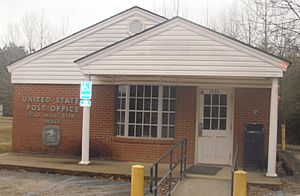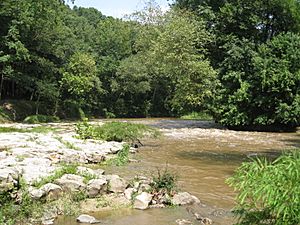D'Lo, Mississippi facts for kids
Quick facts for kids
D'Lo, Mississippi
|
|
|---|---|

D'Lo Post Office
|
|

Location of D'Lo, Mississippi
|
|
| Country | United States |
| State | Mississippi |
| County | Simpson |
| Government | |
| • Type | Mayor-Council |
| Area | |
| • Total | 0.70 sq mi (1.80 km2) |
| • Land | 0.70 sq mi (1.80 km2) |
| • Water | 0.00 sq mi (0.00 km2) |
| Elevation | 299 ft (91 m) |
| Population
(2020)
|
|
| • Total | 373 |
| • Density | 535.92/sq mi (207.02/km2) |
| Time zone | UTC-6 (Central (CST)) |
| • Summer (DST) | UTC-5 (CDT) |
| ZIP code |
39062
|
| Area code(s) | 601 |
| FIPS code | 28-19340 |
| GNIS feature ID | 0669070 |
D'Lo is a small town in Simpson County, Mississippi, United States. It is located along the Strong River. In 2010, the town had a population of 452 people. D'Lo is part of the larger Jackson, Mississippi metropolitan area.
This town became famous for a special reason during World War II. It sent more men to serve in the war, compared to its size, than almost any other town. A huge 38 percent of the men living in D'Lo joined the military! This amazing fact was even featured in Life magazine.
More recently, in 2016, D'Lo was shown on the TV show Small Town, Big Mayor. This reality series on the UP channel highlighted life in the town.
Contents
History of D'Lo
The town of D'Lo was officially started by R. W. May on March 1, 1900. On August 16, 1901, it became an official village. Then, on October 27, 1905, it was upgraded to a "town" by the Governor of Mississippi.
How D'Lo Got Its Name
The name "D'Lo" comes from an older name for the local post office, which was called "Dlo" from 1881 until 1950. The first post office was set up in 1881 and run by Mary Frances May, R. W. May's wife.
The name "Dlo" was chosen by a mail carrier. The first choice, "Millhaven," was not allowed by the Post Office Department. The name "Dlo" comes from a French phrase that means "Bitter Undrinkable Water." This phrase was found on an old map of the area. Just like the Strong River got its name because its water tasted strong (due to tannic acid), "Dlo" was a shortened version of the French phrase "De l'eau non potable..." which means "undrinkable water." Over time, it became "D'Lo."
Growth and Decline of D'Lo
D'Lo grew a lot in 1916. The Finkbine Lumber Company built a huge sawmill there. This sawmill cost $1,000,000, which was a lot of money back then! Finkbine built many houses for its workers. They also opened a large store called Kew Mercantile Company, which sold everything from groceries to farm supplies.
Between 1916 and 1930, when the sawmill was very busy, D'Lo (also known as Millhaven) was the biggest town between Jackson and Hattiesburg. It had many businesses, including:
- Two large YMCA buildings
- A movie theater
- Ten grocery stores
- A furniture store
- Three appliance stores
- Ten gas stations
- Seven butcher shops
- A dry cleaner
- Five cafes
- Three auto repair shops
- A boat building and cabinet shop
- A machine shop
- Three pharmacies
- A bank
- Lighted basketball courts
- Professional basketball and baseball teams
- A newspaper called The D'Lo Herald
The town also had Baptist and Methodist churches. There was a large, three-story brick school with 550 students and 17 teachers. Its Pine View Hospital was considered one of the best hospitals in the region. During this time, D'Lo's population was around 5,000 people. This made it the second-largest milling town in the United States.
However, by the 1930s, the Finkbine Mill had used up almost all the trees in the nearby areas. The sawmill had to close down.
D'Lo After the Mill Closed
When the Finkbine sawmill closed, D'Lo lost many jobs. The town's population dropped a lot. It took several years for the town to start recovering.
Later, U.S. Route 49 was built through the town. This made it easier for lumber companies to reach new areas of trees. A new sawmill opened that supplied wood for weapons and equipment during World War II. Even though this new mill helped the town, it was not as big as the Finkbine mill. The population never returned to 5,000. By the 1940s, D'Lo had about 400 residents, which is similar to its population today.
D'Lo and World War II
Out of about 400 people living in D'Lo, around 150 men served in the Armed Forces during World War II. About 46 men volunteered even before the attack on Pearl Harbor. So many citizens went to war that Life magazine wrote a story about D'Lo on July 6, 1942. The story showed two young boys on the empty streets of D'Lo. The headline said, "D'Lo Men Have Gone Off to War." A monument at the town's community center lists all the D'Lo citizens who served in the war.
The town's name was officially changed to D'Lo on January 1, 1950.
Images for kids
Geography
D'Lo covers an area of about 0.7-square-mile (1.8 km2). All of this area is land.
Population Information
| Historical population | |||
|---|---|---|---|
| Census | Pop. | %± | |
| 1910 | 284 | — | |
| 1920 | 646 | 127.5% | |
| 1930 | 514 | −20.4% | |
| 1940 | 400 | −22.2% | |
| 1950 | 516 | 29.0% | |
| 1960 | 428 | −17.1% | |
| 1970 | 485 | 13.3% | |
| 1980 | 463 | −4.5% | |
| 1990 | 421 | −9.1% | |
| 2000 | 394 | −6.4% | |
| 2010 | 452 | 14.7% | |
| 2020 | 373 | −17.5% | |
| U.S. Decennial Census | |||
In 2000, there were 394 people living in D'Lo. They lived in 179 households, and 114 of these were families. The population density was about 569.7 inhabitants per square mile (220.0/km2).
Most of the people in D'Lo were White (79.19%). About 19.54% were African American. A small number were Native American or Pacific Islander.
About 24% of households had children under 18. Many households (50.3%) were married couples. The average household had 2.20 people. The average family had 2.77 people.
The median age in D'Lo was 42 years old. This means half the people were younger than 42, and half were older. About 20.3% of the population was under 18. About 19.5% were 65 or older.
Parks and Recreation
D'Lo has a fun place called D'Lo Water Park, located on the Strong River. There used to be a movie theater called the "Lux Theatre," but it closed in the 1950s.
Education
The schools in D'Lo are part of the Simpson County School District.
Notable People
Many interesting people have come from D'Lo, including:
- Joe L. Allbritton (1924–2012), a successful businessman
- KhaDarel Hodge, an NFL football player
- Fred James Cassibry, a United States federal judge
- Patrick D. Smith, an author
See also
 In Spanish: D'Lo para niños
In Spanish: D'Lo para niños






